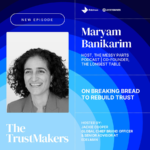By Ross McNab, CRO at Pacvue
Maybe it was a TikTok video about “Amazon kitchen hacks.” Maybe it was someone asking ChatGPT for gift ideas for a plant-loving friend. Maybe it was a Reddit thread that led down a rabbit hole of recommendations. Wherever it was, it probably wasn’t through a search bar.
Welcome to the era of discovery commerce, where shoppers scroll through TikTok the way they once browsed store aisles, and ask ChatGPT for product recommendations like they’re talking to a friend.
It’s a behavioral shift that’s changing everything we knew about how people buy. And for brands, it’s rewriting the playbook for retail media.
From Funnel to Feed: The Rise of Discovery Commerce
TikTok, Instagram Reels, YouTube Shorts – these are the places where modern product discovery happens. And often, that discovery isn’t intentional. It happens in moments of entertainment, rather than in structured search sessions. So, brands are no longer competing only for keyword auctions or shelf space. Now they’re vying for swipes, scroll stops, and double taps.
In 2024, TikTok was the fastest-growing online retailer, with roughly 70 million U.S. consumers purchasing something from TikTok shop over the past 12 months. Its “For You Page” has become a personalized digital shelf, but instead of being organized by category, it’s organized by relevance, emotion, and surprise. This curation transforms passive scrolling into an engaging, individualized shopping journey.
Now layer on Large Language Models (LLMs) like ChatGPT, Claude, or Amazon Rufus.
Where social feeds drive passive discovery, LLMs are unlocking conversational discovery. Instead of searching for “best noise-cancelling headphones,” shoppers can layer in context with questions like “what’s a good pair of headphones for flying every week and blocking out engine noise?” And over time, LLMs can refine and personalize responses based on follow-up queries, preferences, and more. The result is a back-and-forth that feels seamless and natural, which is why almost 60% of consumers now say they turn to AI instead of traditional search to get product recommendations.
Platforms are leaning in, too. Amazon’s Rufus already processes 14% of total search volume on the site. Walmart Connect is exploring conversational ad formats. Klarna has rolled out AI shopping assistants.
This rapid move from intent-based search to algorithmic, AI-driven discovery is flipping the traditional marketing funnel on its head.
A TikTok video can collapse the entire shopping journey – awareness, interest, evaluation, and conversion – into a single moment where content consumption naturally leads to purchasing. Or a shopper might see a product in a TikTok video, ask ChatGPT about it, and then buy via Amazon.
Discovery commerce isn’t linear; it’s layered. And the old retail media playbook based on keywords and last-click attribution isn’t built for these new journeys.
Discovery Commerce is the New Default
Discovery commerce lives in the scroll. In the chat. In the moment where entertainment meets intent and a product finds its way into someone’s life without them even realizing they were looking for it.
These changes feel disruptive because they are. The strategies brands have relied on for years (keyword targeting, upper-funnel ads, traditional search optimization) are no longer enough. And adapting to AI tools and creator-led content will require flexing new muscles.
But brands should be more excited than unsettled. For years, upper-funnel marketing has been notoriously hard to measure and easy to overspend on. Now discovery is becoming something you can engineer.
To follow consumers into this new era of retail, brands need to start optimizing for relevance, not just visibility. That means:
- Partnering with creators on content that entertains while it educates
- Optimizing metadata for natural language queries, not just SEO
- Building product pages to answer questions and show up in real conversations
- Rethinking attribution and measurement
The integration of shopping into discovery-driven environments is making the path to purchase more intuitive, entertaining, and, ultimately, more effective. The brands that adapt first will be the leaders of the next decade in retail.











